Vitamin D: Reclaiming its Rightful Place in Health and Medicine


I have a dream.
I have a dream we can live off the land, breathe in the fresh air, full of electricity that bathes our bodies in perfection, a world where man and animal live in vibrational perfection with nature, where a fundamental principle of life is to respect and never poison or pollute our bodies or our world. Where there is sacredness and carefulness and thoughtfulness. I dream of a world where vaccines are a mere memory of a massive mistake long learned from, where babies are born in nature into calmful and peaceful, welcome, pure waters, where no madmen draw lines in the sky that turn obviously to clouds to then rain down upon the innocent: the animals and the children, with their unsuspecting ways; where there is no natural weather tinkering, where the sun is present and we are connected to natural cycles and the aether once again. We would know how to sustain our lives and never need any idea of any industry whatsoever, as it all would be unnecessary, as we would live in complete communication and flow with our lives, in awareness and trauma-less. We would honour those elders who have retained their memories of history and are brave to share their knowledge. If we were imbalanced, we would use bells or elegant biofeedback to regain homeostasis, we would all hear the plant spirits when they called to us. Art and beautiful culture would flourish. In this world, the idea of disease would have become a mere fairytale of yore…
…however, here we are.
I, too, desire that world. However, as a seasoned clinician with training in various medical disciplines and someone who has battled her own health challenges, including healing from injuries caused by medical doctors and dentists, I have a distinct perspective. My experience with clients and personal experimentation with lab-derived vitamin D (including high dosages) has unfortunately led to conclusions that contradict the recent scrutiny and criticism faced by our life-saving vitamin D.
Now, in saying this, I believe the future is frequency medicine and it’s coming fast. However, we have not arrived there quite yet for the masses or even for the majority of those in the holistic medicine sphere. We still have a long way to go…
A Long History
In my educated opinion (to which we are still entitled last I checked), I find it both unscientific and unprofessional to label an essential vitamin as “rat poison.” This terminology disregards the enormous and successful track record of chemically synthesized vitamins D2 and D3, which have been available since the 1930s and have paved the way for the study of their biological functions and metabolism. When I see such article titles, I cringe because the criticisms they contain often stem from hasty generalizations, revealing a myopic view of research and reeking of a lack of clinical experience, particularly in understanding functional, therapeutic value. Additionally, the cherry-picking of data is a notable logical fallacy in these critiques, along with stacking the deck and suppression of evidence.
The LD50 Rat Poison Criticism
Before we go into more history and other details. Let’s tackle this claim. Chocolate can kill a dog, grapes can kill a cat, and a fat-soluble vitamin given singly into overdose can easily kill a rat, especially void of helper metabolites (like vitamin K2 for certain, additionally vitamin A, magnesium, zinc, and boron) and sure, you could kill anyone or any animal that way through improper dosing. Did you know that excessive water intake can also be fatal? This is a well-established fact, similar to our knowledge about the potential toxicity of iron, various minerals, B vitamins, and all fat-soluble vitamins. We have understood these risks for a very long time.
I am still waiting for the bodies though. I have asked for years to show me the dead bodies of people killed by taking vitamins. Still, I wait.
It’s important to understand that the LD50 was established to study “toxins,” which means this scale describes general toxicity based on limited parameters and lacks controls. The LD50 is the dose that kills half (50%) of the animals tested (LD = “lethal dose”), keep this in mind. It does not account for nutrient overloading, which is a completely different mechanism. Unfortunately, this distinction is often overlooked, leading to the misguided outcry of “rat poison, rat poison!” We should also question whether rats are the appropriate model for studying the efficacy of this vitamin. Think about it. Is the science really “settled” here?
Typically, a superficial glance rather than a rational and scientific investigation suffices for the under-experienced, which means these shocking headlines often end up shaping public opinions despite a lack of deeper understanding or education on the subject. The ethics of crafting such headlines should be carefully considered, especially when they have the potential to deter people from health benefits. Isn’t it important to weigh the impact of sensational headlines against the responsibility to inform accurately and constructively?
The good news, is you don’t have to use it if you don’t want to! You have freedom of choice (at least for a little while longer.) If we chatter about it too much, Big Pharma might just take you up on that offer. I am sure they will gladly come up with a “rickets vaccine” to give out to our children, instead of an affordable supplement or restrict vitamin doses (as they’ve been working on for years with Codex Alimentarious) because “too many people are misusing it.”
Unfortunately, many people face limited options, tight financial constraints, and dire circumstances. In such situations, vitamin D supplementation can be a lifeline, helping them emerge from a very dark and melancholy place, something I have witnessed firsthand.
But I am getting ahead of myself. Let’s start at the beginning, shall we?
What about rickets?
You might think that with all our education, we have solved our vitamin D deficiency problems. Think again! Vitamin D deficiency is on the rise due to increased indoor living, blue light exposure, cloud seeding programs, stress, toxic exposures, and nutrient-depleted food.
1650–1890: history of vitamin D deficiency (rickets and osteomalacia)
1890–1930: history of the discovery of vitamin D and its structural elucidation
1930–1975: history of the discovery of vitamin D metabolites including 1,25-(OH)2D3
1975–present: history of the discovery of the vitamin D cellular machinery, functions and vitamin D-related human diseases.
I am going to include the entire introduction section of this paper here because if we’re going to speak about something with a history, we’d better go right back to the beginning and see how it was first used.
”An adequate serum concentration of Vitamin D (acting via its active metabolite) is required for optimal absorption of calcium from the gastrointestinal tract. This vitamin D concentration or status is maintained by either endogenous production following ultraviolet B (UVB) irradiation of the skin, or from dietary intake (although without supplementation/fortification diet alone is unlikely to meet normal daily requirements).
When Vitamin D deficiency occurs, calcium absorption is reduced and furthermore when accompanied by low dietary calcium intake can lead to total body calcium deficiency and compensatory hyperparathyroidism. Elevated parathyroid hormone concentrations results in phosphaturia and low serum phosphate levels with resultant abnormal bone mineralisation. In adults, this mineralisation defect results in osteomalacia (impaired mineralisation of bone matrix) and osteoporosis (reduction in the amount of bone). In children, osteomalacia can be accompanied by growth plate abnormalities (nutritional rickets). Rickets is specific to children due to their open growth plates and results from a combination of poor mineralisation of the primary and secondary spongiosa and the lack of chondrocyte terminal differentiation caused by hypophosphataemia (1).
There are multiple causes of rickets, but vitamin D deficiency, usually in concert with dietary calcium deficiency, is the leading cause with an incidence of between 3 and 10.5/100,000 in prospective surveillance studies (2–5). The classic features of rickets include: flared wrists, lower limb bowing, rachitic or rickety rosary, poor growth, delayed dental eruption and enamel defects, bone pain, myopathy, and motor developmental delay (2, 4). In rare instances pathological fracture may also occur (2, 4). The most clinically significant associated feature of nutritional rickets is biochemical hypocalcaemia, which results from total body calcium depletion, and is more likely to present in infancy/early childhood (6) (i.e., periods of rapid growth). As extracellular calcium is essential for normal nerve and muscle function, low serum calcium can result in neuromuscular excitability which in severe cases can result in tetany and hypocalcaemic convulsions (4). Hypocalcaemic myopathy can also manifest in cardiomyopathy and occasional death.
Nutritional rickets can be almost fully prevented by universal supplementation with 400 IU of cholecalciferol (vitamin D) of all infants for the first 12 months of life and the continued supplementation of all children at risk of vitamin D deficiency.”
As I said, life-saver. Did you hear that part where they said without supplementation diet alone is unlikely to meet normal daily requirements?
Of course, Vitamin D should be paired with its metabolites. This is where we get into muddied waters: studies that show no benefit or try to prove harm, supplementation causing renal impairment, hypercalcemia, vascular calcification, and an increased risk of kidney stones. That is called improper prescribing, ignorance of the body, and terrible study models.
What are the Fat Soluble Vitamins?
Back to basics for a moment. There are 4 fat-soluble vitamins. They are A, E, D and K (two versions, K1 and K2 but those are a longer explanation), and these are quickly accumulated and stored in the body, generally in the liver. All fat-soluble vitamins—and indeed all vitamins, but especially so the fat-soluble ones—can become toxic at excessively high storage doses, whether naturally sourced or lab-derived. Conversely, having too little of each can lead to detrimental outcomes. This isn’t new information; the knowledge of hypervitaminosis and vitamin deficiencies, along with the various appropriate and inappropriate dosages for different life forms, including animals and humans at different life stages, has been known for quite some time.
When studies are performed with single dosing there are mixed outcomes. Does vitamin A help to prevent many cancers, or not? Does vitamin D? How about a combined approach? Most studies are single vitamins only. That’s called a bad study design. Many against vitamin D will source such studies as evidence of danger, leaving out the vital knowledge of how nutrients work together, in synergy and balance, in biochemical reactions in the body for proper metabolization. But we’ll get to that more in a moment.
What is Hypervitaminosis?
As I mentioned, all vitamins and minerals have upper levels that can produce toxic symptoms when overdosed or taken in imbalance. Here is a chart to help you understand the symptoms seen when it is too much.
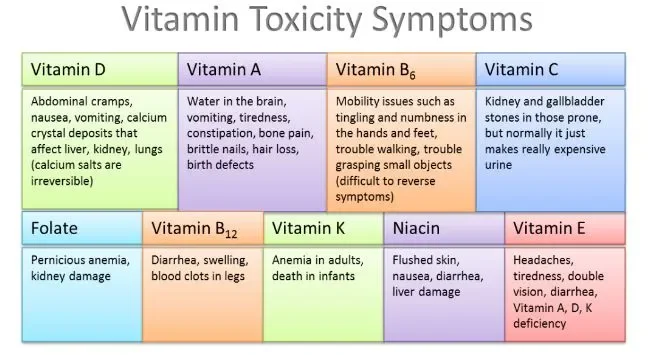
What does Vitamin A toxicity look like?
As I was saying, the metabolism of these vitamins work together (can you believe they can affect one another? Amazing!) and need other metabolic co-factors and co-regulators or they can deplete one another (as biochemistry uses stored nutrients to create action upon the body) and cannot be transformed by the body. Too many people are imbalanced, missing key co-factors, or have genetic mutations that refuse to allow for proper metabolic pathways to work. Critics of Vitamin D need to look at these nuances before kicking cholecalciferol to the curb.
Presenting selectively chosen vitamin D3 studies without providing fair and balanced information, while overlooking the fact that each vitamin collaborates with co-factors and interacts with synergists and antagonists; that there are various individual metabolisms with all their accumulated damage; that there can be overdoses of all vitamins; serious deficiencies, as well, that these vitamins have prevented and healed in millions of people of all ages, is both misleading and frankly, disingenuous. There are upper limits to all supplements (and really, all things in life), and high doses of vitamin D taken in imbalance can cause imbalances. Great! We agree then.

Source: Vitamin D3 cofactors. Disregard the germ theory term “immunity.”
It’s a Hormone! Gasp!
“Oh, what? It’s a steroid! Oh, hell nah, better stay away from that!” Good one, guys. As if less nutrition is what the masses need. Vitamin D’s trait as a steroid-like substance is hugely important. It means that it has progesterone-like effects on the body, which is a vital hormone that many are chronically depleted of. This holds immense promise for fertility issues, such as preventing miscarriages. Those who mislabel this valuable trait of vitamin D to demonize it should not be trusted, especially if they fail to explain these nuances. Currently, there is a war on fertility and a massive drop in fertility rates worldwide. We need all the help we can get.
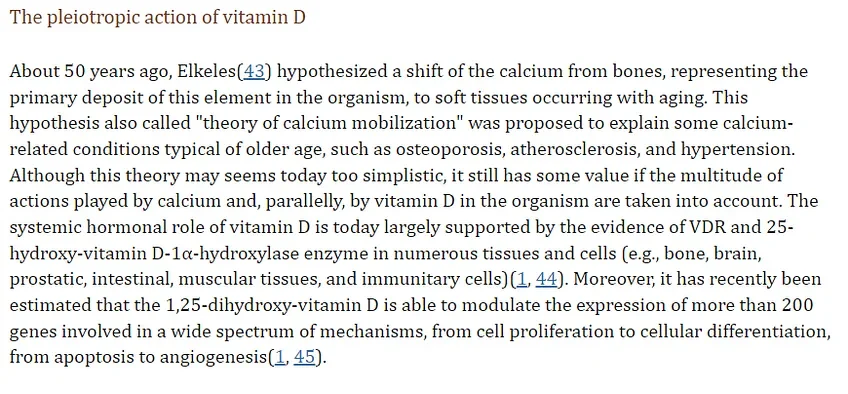
Vitamin D as a hormone is vital for genetic activity
Vitamin D, a secosteroid (pro)-hormone, is traditionally known for regulating bone metabolism and maintaining calcium and phosphorous balance in conjunction with parathyroid hormone. In recent years, its role has expanded, revealing a pleiotropic influence across various systems, organs, and tissues. This has positioned Vitamin D as a key factor in various biological changes and specific clinical conditions, especially its impact on skeletal muscle, physical function, and age-related decline. This has massive health implications, especially for our elders.
Just Get it from the Sun!
Once again, education wanes as not everyone lives in California or Florida.
The synthesis of vitamin D in the skin is the most important source of vitamin D and depends on the intensity of the ultraviolet irradiation which is dependent on season and latitude. For example, in Boston (42.2°N), no vitamin D is produced from sun-exposed skin from November to February, while in San Juan (18°N) the skin produces vitamin D all year. Melanin and sunscreen markedly diminish the production of vitamin D (194, 483). Vitamin D can also be taken in the diet. However, vitamin D is present in only a few foods (which include fortified dairy products and fish oils). Vitamin D3 itself is not biologically active. Vitamin D is transported in the blood by vitamin D binding protein (DBP; which binds vitamin D and its metabolites in serum) to the liver.
Source: Vitamin D: Metabolism, Molecular Mechanism of Action, and Pleiotropic Effects
People often apply so much toxic sunscreen, even on rare sunny days, that they inadvertently block their Vitamin D absorption. Realizing this fact, I designed a natural sun cream. This cream allows for Vitamin D production while still preventing sunburn. Get a tan, plus vitamin D, plus avoid burning? Triple win.
Is it the Vitamin or the Individual?
Some people will approach their metabolic disarray by avoiding the nutrients that give them overdose symptoms RATHER THAN ADDING the partners to their biochemical story to help them metabolize properly. Another approach would be to work on healing the gut, addressing epi-genetic mutation switches which will repair protein folding, upregulate enzyme production, stimulate proper purging mechanisms (in the case of MTHFR mutation and regarding vitamin D, CYP2R1 mutation), and repair that individual’s terrain damage so these vitamins can function (this happens whether synthetic or natural source, FYI). I prefer to repair the damage, rather than avoid the healing. It is also important that we look at medicine with terrain eyes and individualize it to the patient.
Although the identification of mechanisms mediating VDR-regulated transcription has been one focus of recent research in the field, other topics of fundamental importance include the identification and functional significance of proteins involved in the metabolism of vitamin D. CYP2R1 has been identified as the most important 25-hydroxylase, and a critical role for CYP24A1 in humans was noted in studies showing that inactivating mutations in CYP24A1 are a probable cause of idiopathic infantile hypercalcemia. Source.
Just because you can’t metabolize something doesn’t mean everyone else can’t either. It’s become a social trend to expect others to change to accommodate individual insufficiencies and traumas, rather than focusing on personal health. However, if you have an issue with a particular vitamin, that’s specific to your body, and not necessarily how everyone else’s body functions. There might be a few others like you, and you’ll need to navigate your health and figure out your imbalance in your way. We can co-exist with these differences, which is wonderful.
Can’t Ignore the Benefits
The numerous benefits of vitamin D, as evidenced by countless studies, personal testimonials, and a plethora of books on the subject, should not be overlooked or dismissed. To learn about the many benefits, you can visit Vitamin D Wiki, but it is just a general idea of how valuable and essential vitamin D3 has been. (Just a caveat regarding the Wiki page that suggests Vitamin D for “covid”, we know there was no new disease (it was the flu rebranded), however vitamin D will support the cleansing actions of the body and assist the liver which will upregulate the removal of wastes and debris hence reducing detox (aka cold and flu) symptoms and hence the positive studies that you will see on that website.)
I have been personally taking (high doses) and recommending vitamin D3 in both low and orthomolecular doses for close to 20 years now with proper prescribing and helping many, many people heal in various ways doing so. I know I recommended it when my Grandmother was dying of ovarian cancer and the doctors misdiagnosed her (2002). I had figured out how she could heal it without the death cults’ chemo/ radiation/ surgery triad. Of course, she didn’t listen to me.
So, after all my efforts to help people heal using the tools at my disposal, as I take much time and energy to teach and guide with excellent results, how is it that I find myself met with name-calling and slander, devoid of any genuine debate or discussion? Is this really what’s come of things? No composed, thoughtful debate, just sensational, overly emotional reactions, and aggression? This hardly seems professional.
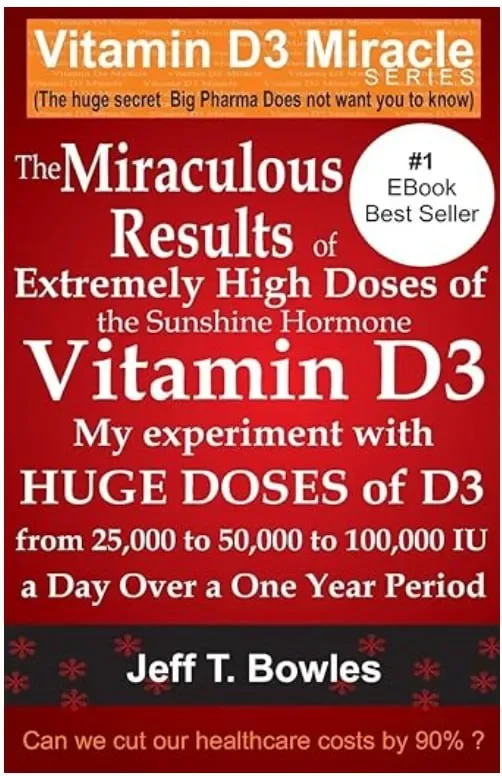
Here is an author who has tested massive doses of Vitamin D with success.
I get the feeling harsh critics have not experienced deaths-door patients day in and day out for anything close to that length of time and witnessed the outcomes of correcting their terrain with these remedies. To perform a type of witch hunt on those of us practiced in this way, claiming that promoting vitamin D is not only wrong and hurting people, but to slander and label excellent medicine men and women as controlled opposition gatekeepers is like watching an episode of the Twilight Zone.
Of course, there are multiple ways to obtain pre-vitamin D, via the sun (when available), via foods (limited sources) for example certain mushrooms, dairy, oranges, and fish. Any decent natural practitioner will address the patients’ food regime and work to create a simpler version of extracts for remedies as much as possible. Which is why I wildcraft plant medicine and share as much of it with the world as I can. That does not negate the rightful role vitamin D supplementation has to offer, so perhaps try to give it a little room to breathe.
I’ve assisted numerous patients in reducing their reliance on heavy pharmaceutical drug regimens, which often alarmed me when reviewing their prescription lists. These drugs can lead to severe vitamin deficiency syndromes. Here’s just a brief overview of some of these deficiencies. The initial step with such patients is to address overt deficiencies. This is where lab-synthesized vitamins often play a crucial role, guiding them to the next stage of recovery successfully and affordably.
Adjusting a patient’s daily eating habits, which are often deeply ingrained, requires time and patience. The journey typically involves a gradual weaning-off process. During this time, vitamin supplementation acts as a safety net for when daily nutritional intake falls short or when patients face additional detoxification or metabolic challenges. Compliance is another crucial factor, necessitating a range of options to suit different needs. Additionally, any extra health challenge, including high physical, mental, or emotional stress, increases the body’s nutrient requirements. It’s during these times that deficiency symptoms are most pronounced and supplementation can be called for.
The Method is not the Product
Something else I witness about those who critique vitamin D is the method of extraction. It is a logical fallacy argument to say because the methods of extraction are considered toxic or unsavoury, so-to must be the product. This is an obvious logical error. The end product contains nothing of the intermediaries so should not be considered to be toxic by mere association. I hope we can meet logic here, together, as science would want.
So how is Vitamin D3 made? The synthesis of Vitamin D3 in a lab involves a multi-step process starting with 7-dehydrocholesterol extracted from lanolin in sheep’s wool. This compound is irradiated with UV light to form pre-vitamin D and then heated to produce Vitamin D3. Here’s a simplified outline of the steps:
- Preparation: Begin with a small quantity of 7-dehydrocholesterol.
- UV Irradiation: Place the compound in a reaction chamber with a UV mercury lamp, keeping the reaction temperature controlled.
- Solvent Addition: Add ethanol to dissolve the compound for efficient reaction.
- Enclosure and Safety: Ensure the reaction is sealed and enclosed in a box to prevent UV exposure.
- UV Exposure: Irradiate the solution with UV light for a set period.
- Heating and Transformation: Transfer the irradiated compound to a flask for heating, transforming it into Vitamin D3.
- Final Steps: Use a rotary evaporator to remove ethanol, leaving behind a powder mixture of Vitamin D and unreacted 7-dehydrocholesterol, which is then purified.
Extracting gold from ore doesn’t entail consuming the rocks and minerals with the gold. With my chemistry background, I understand using various substances in the lab to direct materials toward our goal. We meticulously wash away these substances and purify them at each stage, advancing step by step. When examining vitamin extraction charts showing the so-called “scary” methods of creating vitamins from raw materials, it’s crucial to keep this process in mind. This aspect is often one of the unsubstantiated arguments critics use against lab-derived vitamins. There’s a noticeable trend of underhanded tactics employed to dissuade people from using vitamin D produced by this method.
Another recent trend has involved attacking vitamin B12, seemingly driven by individuals seeking social media “likes.” This trend is likely to continue with similar critiques of other vitamins and medicinal compounds, illustrating the tendency to prioritize sensationalism over substantial, individual, and nuanced information.
Someone came at me, hard, by saying that B12 comes from RAW SEWAGE. “Oh my gosh! That’s terrible! Hey Judy, we need to stay away from that vitamin B12, I heard it comes from sewage! Oh wow, Betty! I didn’t know that! I guess my essential tremor will have to stay!” Sure, cyanocobalamin is the synthetic version of B12, whereas methyl is the “natural” form and the one I prefer to use. BUT ALL VITAMIN B12 IS MADE VIA BACTERIA. Did that person say that when he went off about “raw sewage?” Of course not, for that would be a rational and balanced way of thinking. Well, looking into it, they use e.coli to create the cobalamin which feed off wastes to produce it, because that’s what e.coli does. And????? Do you see how twisted that is to make it sound devious and gross?
Fact: Incorrect dosages of vitamins and minerals can cause imbalances. That doesn’t discount its value.
Speaking of value…Individuals in low-income urban areas often have limited access to open spaces and may work long hours indoors, reducing their sun exposure. Additionally, socioeconomic factors can influence dietary choices, limiting access to Vitamin D-rich foods such as fatty fish, eggs, and fortified products, especially now with the prices of meat (and all food) escalating.
The ramifications of Vitamin D deficiency are substantial, not only for risks of rickets in children and osteoporosis in the elderly, but also for bone pain, muscle weakness, and greater susceptibility to toxicity build-up which leads to chronic inflammation and microbial events (aka “infections.”) In adults, severe deficiencies can contribute to osteoporosis, cancer and a heightened risk of falls and fractures, to name a few.
Vitamin D supplements offer a practical solution for issues of public health, perhaps those chatting in their privileged echo chambers have forgotten about that, but even the low cost of vitamin D can be prohibitive for many low-income populations. Hence, it is vital to advocate for subsidized or low-cost Vitamin D supplementation programs, especially in areas with limited sunlight exposure or where dietary sources are scarce.
Public health initiatives should include education about Vitamin D sources and the importance of sun exposure. Community-based interventions can be effective, such as creating safe green spaces in urban environments and incorporating Vitamin D screening and supplementation into existing healthcare services for underserved populations.
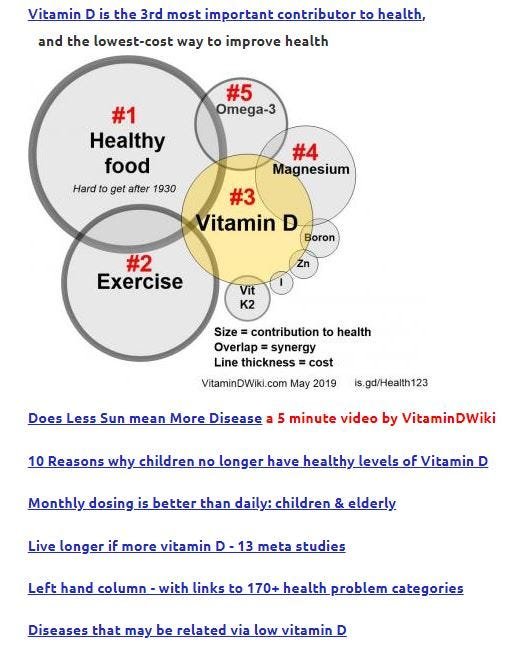
A Toxic World
More so now than ever before, due to the increased level of exposure to poisons like vaccines, geoengineering technology, frequency weapons, microbial damage (from antibiotics and their residues), blue light, EMFs, nutritional deficiencies, stress, congested livers, clogged gallbladders, weakened kidneys, hormone imbalances, and the list goes on…we are witnessing genetic damage leading to imbalances of metabolism.
Some are so poisoned and damaged by generations of toxic exposures that they can’t even metabolize a piece of fruit without symptoms. I had a young patient just like this. Are we to now warn everyone and encourage them to stop eating fruit? You can see how ridiculous an idea that is. Many supplements agitated him and too many foods to name. Just because someone has a COM-T mutation or has detoxification challenges doesn’t mean the supplement is dangerous or poisonous. It is like saying peanuts are dangerous because some people have an anaphylactic reaction to them.
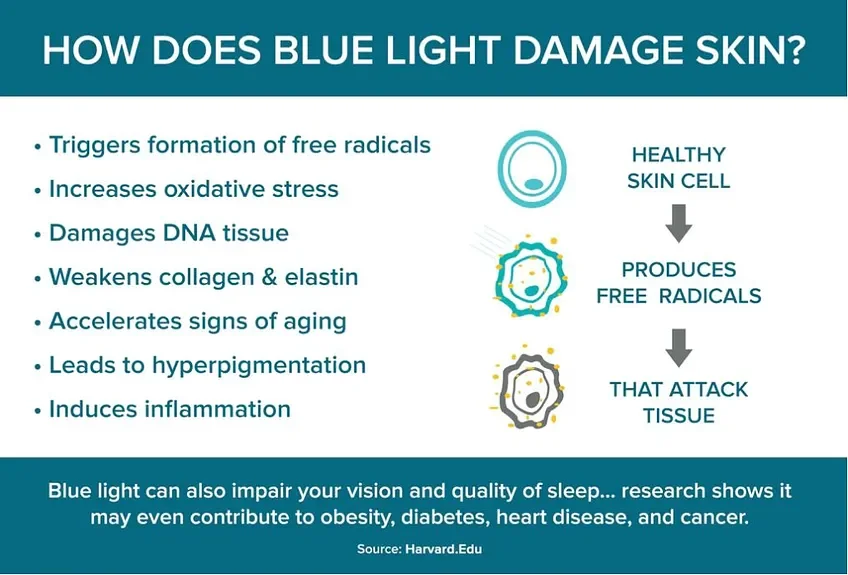
Glyphosate damage? Absorption issues? Metabolic problems? Obesity? What about the gut? Is the microbial setting in proper form? Real poisoning halts many normal functions. However, we need to stop demonizing vitamin D because of individuals who are very toxic, metabolically imbalanced, or lack the knowledge to research proper dosing of such a well-established remedy. One can’t just randomly throw vitamins into a broken system and expect them to work.
How we heal is to clean up the terrain and re-nourish the system with vitamins and nutrients. Ignorance, on the one hand, is misunderstanding proper uses, and then there is a sense of entitlement on the other hand, demonizing its very existence. Then wonder why the alphabet agencies are laughing at us all the way to the bank (and the legislature?) Can we please walk down the middle path and temper our discussions so they are fruitful? After all, don’t we want health and well-being above all else?
One can’t just randomly throw vitamins into a broken system and expect them to work.
~ADV
Veganism and Vitamin D
I was a vegetarian since age 16 then became a staunch vegan in my late 20’s (and raw vegan for 2 years) until I realized my deficiencies when trying to conceive a child at age 35 and miscarried. One of my deficiencies was vitamin D. Many vegans suffer from brittle bones or easily broken bones due to a lack of this important vitamin. I recently learned of another vegan with a cracked rib caused by coughing who lived in a city with very little sunlight exposure. Boris Grinblat, in my interview with him and his wife, also experienced broken ribs as a vegan. In our interview, we discussed veganism from a nutrient perspective, taking the emotion out of the analysis.
As a vegan, I only took Vitamin D occasionally but thank goodness I was exposed to it in Naturopathic College where I started to learn more about it and use it, I am convinced it bought me time as I figured out my lifestyle. My cravings took over anyway and I introduced local eggs, chicken, nutrient-dense bone broths, and organic beef into my diet which I know sustained my pregnancy. My placenta was glorious and rich in colour. Witnessed, are the placentas of vegetarians and vegans looking pale and damaged. There is no dairy in a vegan diet and the spleen-stomach pair becomes taxed over time (in Traditional Chinese Medicine (TCM) called spleen chi deficiency) decreasing the absorption of calcium from greens significantly, adding insult to injury. The only way I was able to maintain the vegan lifestyle in Canada with long winters was with supplementation and I only did better once I stepped up my supplement routine, however, even this failed me when my nutrient levels had to massively increase after I conceived. I also miscarried once before I figured it all out. The main demographic of vegans will need lab-created vitamin D if they wish to maintain their health, simple fact. There are vegan options available derived from lichen. Yes, still lab-derived. How do you think we make extractions of plant or animal medicines, anyway?
For example, I have designed many salves, creams, and lotions. To do this I need to extract the medicine from the raw materials. I may use heat, alcohol, or DMSO to crack open the cells and make my extractions. This is what labs also do. They take the raw materials and work to extract them. Then they will refine, isolate, and select specific aspects of the plant to “standardize.” Are people being ignorantly biased about manufacturing processes?
When it comes to pharma drugs, this process takes things even further. More refinement happens, then altering the original excipients, then mixing them with other refined excipients and truly “playing chemistry” until they have tinkered enough to have a rapid, intense, and overpowering, overriding effect on the body. A drug like this will overwhelm the life force, will topple over the directive of the body, and will cause metabolic action with a resultant chaotic blowback (side-effects). Drugs are manufactured with a false idea in mind: that symptoms are bad and must be stopped, no matter what. They ignore the elegant combination of factors involved when the body is trying to heal, suppress natural action, work against that action, override it, and cause deficiencies along the way. This is what makes something “lab-derived” truly dangerous.
From where I stand, the Vitamin D attack takes none of these factors into effect. This compound, when given, will take action upon the body to heal a deficiency, to assist a release, to support a repair, and not to override the body’s innate intelligence. That is the real nuance between “natural” and “synthetic.”
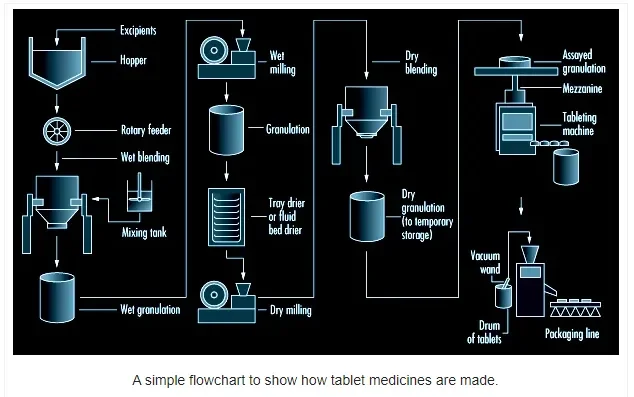
The Corrections
Corrections to health may produce symptoms, they are generally of the cleansing kind but they are helpful, short-term releases that have an outcome benefit. For example, when in deficiency and the dose is administered, a headache or migraine can occur, this is a response to the sudden increase in hormone production, and it can sometimes be tricky to navigate delicately. I have treated many patients who experience aggravation or a healing crisis even with minimal doses; they are often that toxic, notably those with fibromyalgia and chronic fatigue.
Late-stage cancers, being highly toxic, can also lead to more significant aggravation. Nonetheless, the pattern is consistent: after overcoming the healing crisis, health steadily improves. This response indicates a reactivated healing process, not poisoning by a supplement. With extensive experience in such cases, one gains a deeper understanding. Providing comprehensive support helps patients navigate their healing more comfortably, with reduced symptoms.
Poisoned or Cleansing?
How many people can differentiate between deficiency symptoms, excess symptoms, or cleansing symptoms?
Let’s sort that one out then, shall we?
Deficiencies are slower, cooler, ulcered, unproductive, feeble, withdrawn, and often dry.
Excess conditions are hotter, faster, fuller, tumour producing, exudating, more yellows and reds in colour, but can quickly create deficiencies if long-standing. Commonly, this begins with signs like constipation. Toxicity symptoms are in this category, excess but again can burn out from long excess and start to show specific deficiencies (like bowel motility).
Cleansing symptoms are purgative in nature: mucus-producing, looser stools, sometimes vomiting, loose exudates from eyes, and ears, needing more sleep, encourages fasting as it uses the gastrointestinal system to gather wastes from the body for removal. Sweating also happens here and it can help to control the sweating with 20-minute hot baths and then wrapping up in bed to continue to sweat, it can help to release the body’s burden of various toxins. Real toxins, like improperly created heavy metals, cause a variety of issues to the health and well-being of the terrain.
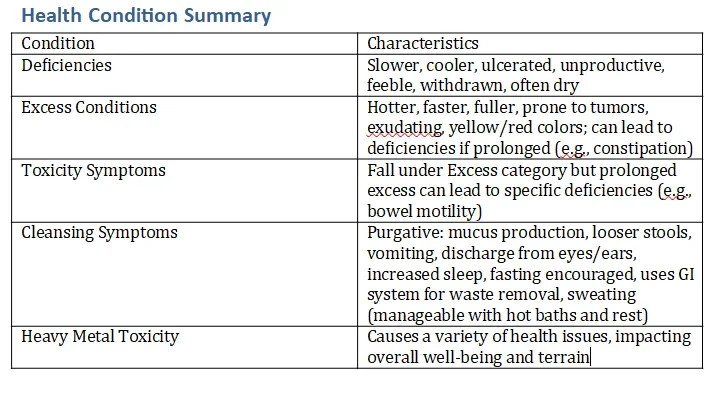
The health crisis can be intense and even end one’s life if not approached carefully. Ensuring the organs of elimination are flowing well is very important before simply throwing supplements around.
Examples of Vitamin D successes and failures.
In the case here of kidney failure due to large amounts of Vitamin D, this man was not taking anything to balance out this dose, we also know nothing of his toxicity levels. Was he even eating properly? How was his gut health? This was an incorrect protocol and the ND failed at their job. If they understood how to properly use vitamin D, it all could have been avoided. We do understand vitamin D well, including its relationship with calcium intake, mucosal interactions, kidney and cholesterol involvement, and its presence in numerous organ systems. Similar to DMSO, it is a substance that needs some knowledge for correct use. Just like driving a car, cooking on a stove, or just about everything in this realm.
I recall a patient who was on the brink of self-harm during the winter and I suggested 10,000 IU Vitamin D with K2 from supplements. She was already taking magnesium, zinc, and iodine and her diet was well-balanced. When I followed up with her a week later she said the fog had lifted from her and she could function again. No need for hazardous and poisonous psychotropic medications and anti-depressants that keep you addicted and hollow.
So many people have fat malabsorption. This can lead to deficiencies. Supplements here, in higher doses, can be life-saving. Often we cannot obtain orthomolecular doses through food or expensive food-based supplements. We have an epidemic of gallbladder removal surgeries. The liver is already overburdened in these cases and often full of stones. When we teach our patients to cleanse and support their vital organs to repair this is how we make them stronger, this is how we lead them out of their chronic deficiencies and teach them how to prevent further disease.
Experience from an HDoT Member:
”I know someone who’s listened to that FB and how vitamin D is a “dangerous rat poisoning hormone.” Her baby started seizing at 6 months. (Do you know what meds are used to “control” epilepsy?) This baby healed at the age of 6 y. in 7 days on high vitamin D3 and K2, and never needed any meds (or monitoring of every organ by a specialist because it can shut down from medications, any day) .
Almost 7 years of unbelievable pain and suffering, no future – all turned around IN SEVEN DAYS.
Be careful what you believe. It may cost a life.
I spent a year learning. Vitamins all the way…”
Another member writes:
”My experience with high doses of Vit D – when I was flying back home after dental surgery in Germany my biological surgeon advised me to take high doses of vitamin D in case I was feeling exhausted during the flights. He said: don’t be afraid to take even as much as a teaspoon once or twice a day.
2 teaspoons are close to 200,000 IU
Also, his requirement to accept a client for a surgery was a stable Vit D serum level above 70 ng/mL, if I remember correctly
Occasionally I still do take a high dose if needed and always feel its benefits pretty quickly.”
Another member writes:
”I’ve been learning about the two different types of Vit K2 recently (MK-4 and MK-7). I have been taking Vit D3 5,000 IU for years (since around 2009 or 2010) but have never taken Vit K2 with it.” You can read it all here if you like, but essentially she was also instructed by her misaligned ND to take additional calcium 600mg per day! This would be a worst-case scenario for vitamin D and all she had was some stiffness in some of her joints that halted when she stopped taking the calcium. She hadn’t even added in the K2 yet or any other possible co-factor deficiency (like boron) although she also started using magnesium citrate to help move excess calcium out of soft tissue soon after stopping.
I could go on, but I think you get my point.
How to Dose Properly
Is the sun better? Yes. Is the sun essential for all life? Yes. Is as close to nature’s source as humanly possible ideal? Absolutely. Last month here in Ontario, Canada we had only two sunny mornings and one full day of sun. Sure, you can use a full spectrum bulb or a SAD lamp to help with mood, certainly, but that doesn’t help you make any vitamin D. I will continue my supplementation in the higher ranges as I have a lot of success for my own health and in many severe disease cases.
In the case of vitamin D overdosing, supplementation should be stopped or at least halved and, if indicated, serum calcium levels should be measured. In the case of vitamin D3 intoxication, which is an extremely rare condition (less than 1% of people) when hypercalcemia occurs due to the use of vitamin D3 supplements, supplementation should be stopped, and the treatment of hypercalcemia should be applied (see [51,58,59] for details).
Source
Recommended dosing: https://www.ncbi.nlm.nih.gov/pmc/articles/PMC8709011/
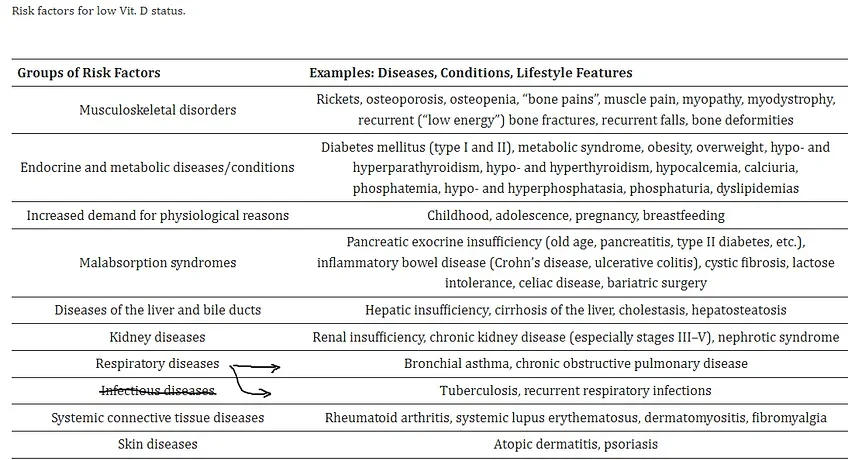
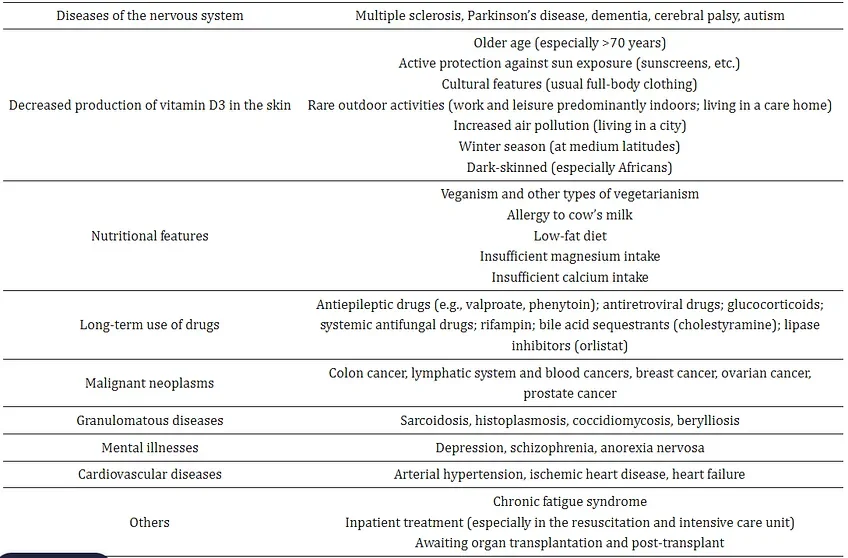
Were you aware that low vitamin D status leads to less absorption of magnesium, a mineral most are deficient in? This means with low vitamin D levels, you are most likely also low in magnesium, another chronic problem in our world. Magnesium is critical for converting vitamin D to its active form in the body and aids its transport in the blood. Observational studies show that both vitamin D and magnesium intake are associated with improved protection against insulin resistance, type II diabetes, and even death from any cause. These two should always be taken together.
Whenever possible, I will choose to employ Cod Liver Oil (if not requiring to use large, orthomolecular doses to correct something more severe).
We also carry a very potent sublingual Vitamin D supplement that is rapidly absorbed in the mouth and bypasses gut absorption. This is perfect for those with leaky gut, gallbladder issues, autism, and diabetes. that are incredible for cases of autism.
I personally use Clive de Carle’s Vitamin D which is 10,000 IU per capsule when I use high doses. He also carries a version for vegans.
Take at least 1000IU daily if you are only getting low or little sun. This is a good supplement for adults or children from Biomed for those who refuse cod liver oil.
Vitamin D3 and K2 should be taken together, as K2 is one of the main shuttles that delivers calcium to the proper tissue, primarily the bones. This prevents all those problems of calcium being deposited in incorrect tissue. The daily recommendation for K2 is 120 mcg and the general recommended ratio is 1000 IU D3:10 mcg K2. I like this one with coconut oil from Orange Naturals. As well as this one from Activation Products, stored in a dark purple Mirion preservation glass that prevents rancidity.
In addition to magnesium, it is important to also take it with zinc, boron and beta carotene. For men, especially, the zinc they take should be balanced with copper.
If you are looking for a food-based supplement this is a good one.
We are electromagnetic beings, and everything we ingest aims to fuel this system. Sungazing practice could be used, where the pineal processes UV light from the sun to fuel the body. Ultimately, we need no food or water, but very few have the lifestyle capable of achieving this. It is ideal? Sure. It is realistic? No.
There are numerous ways to achieve optimal health and balance. Some methods are perfect, others cautious, clever, or elegant. While we could delve into philosophical debates about these approaches, it’s crucial to avoid confusing the public with biased attacks on life-saving supplements and their users. Instead, focusing on well-informed, unbiased information is key, rather than fostering fear or misinformation.
It’s also important not to criticize practitioners who incorporate supplemental vitamin D or other lab-derived supplements into their practices. Supporting one another, practicing humility, and respecting individual health journeys are essential. We will continue to strive toward the perfect, the ideal, the dream…for now, we will work with the helpful tools that we have to get people off pharmaceutical, suppressive drugs that are truly holding mankind back.
The real pill that people need to stop taking is the black pill.
Resources:
The Role of Vitamin D on the Wound Healing Process: A Case Series
https://www.ncbi.nlm.nih.gov/pmc/articles/PMC10075270/
Cod Liver Oil Recommendations
https://www.westonaprice.org/health-topics/cod-liver-oil/cod-liver-oil-basics-and-recommendations
Hypovitaminosis D and Risk Factors in Pediatric Epilepsy https://bmcpediatr.biomedcentral.com/articles/10.1186/s12887-021-02906-7
Epilepsy and vitamin D: a comprehensive review of current knowledge
https://pubmed.ncbi.nlm.nih.gov/27988507/
Vitamin D for the Treatment of Epilepsy: Basic Mechanisms, Animal Models and Clinical Trials https://www.frontiersin.org/journals/neurology/articles/10.3389/fneur.2016.00218/full
Vitamin D in treatment of seizures: https://www.frontiersin.org/journals/neurology/articles/10.3389/fneur.2016.00218/full
Vitamin D prophylactic doses
https://www.ncbi.nlm.nih.gov/pmc/articles/PMC8709011/table/nutrients-13-04415-t003/
Hypocalcemic Seizure Due to Vitamin D Deficiency https://www.ncbi.nlm.nih.gov/pmc/articles/PMC7584818/
Vitamin D Dosing: Basic Principles and a Brief Algorithm (2021 Update) https://www.ncbi.nlm.nih.gov/pmc/articles/PMC8709011/
Vitamin D Wiki
https://vitamindwiki.com/VitaminDWiki
A Brief History of Nutritional Rickets https://www.frontiersin.org/journals/endocrinology/articles/10.3389/fendo.2019.00795/full
100 YEARS OF VITAMIN D: Historical aspects of vitamin D https://www.ncbi.nlm.nih.gov/pmc/articles/PMC9066576/
History of the discovery of vitamin D and its active metabolites https://www.ncbi.nlm.nih.gov/pmc/articles/PMC3899558/
SAR and QSAR modeling of a large collection of LD50 rat acute oral toxicity data https://www.ncbi.nlm.nih.gov/pmc/articles/PMC6717335/
Fat-Soluble Vitamins https://www.ncbi.nlm.nih.gov/books/NBK218749/
Which vitamins and minerals should be taken together or separately? https://www.consumerlab.com/answers/which-vitamins-and-minerals-should-be-taken-together-or-separately/how-to-take-vitamins/
The Synergistic Interplay between Vitamins D and K for Bone and Cardiovascular Health: A Narrative Review https://www.ncbi.nlm.nih.gov/pmc/articles/PMC5613455/
Food Sources of Vitamin D: https://www.dietaryguidelines.gov/resources/2020-2025-dietary-guidelines-online-materials/food-sources-select-nutrients/food-sources
Vitamin D Nutrition Source https://www.hsph.harvard.edu/nutritionsource/vitamin-d/
Drug-Induced Nutrient Depletions: What Pharmacists Need to Know https://www.uspharmacist.com/article/druginduced-nutrient-depletions-what-pharmacists-need-to-know
Vitamin D Facts Sheet https://ods.od.nih.gov/factsheets/VitaminD-HealthProfessional/
Sample preparation techniques for extraction of vitamin D metabolites from non-conventional biological sample matrices prior to LC–MS/MS analysis https://www.ncbi.nlm.nih.gov/pmc/articles/PMC9174318/
In Defence of Vitamin D
https://blog.insidetracker.com/in-defense-of-vitamin-d
Vitamin D Cofactors in A Nutshell https://vitamindwiki.com/Vitamin+D+Cofactors+in+a+nutshell
The Vitamin D Hormone: A Multitude of Actions Potentially Influencing the Physical Function Decline in Older Persons https://www.ncbi.nlm.nih.gov/pmc/articles/PMC4384440/
The interactions among vitamins A, D, E, and K: Synergy and/or competition https://www.researchgate.net/publication/286474644_The_interactions_among_vitamins_A_D_E_and_K_Synergy_andor_competition
Join Amandha’s Private Community!
Participate in specific health related groups, engage with holistic healers, educate yourself with step-by-step online courses, join Amandha in weekly video chats, and reach the ultimate natural health lifestyle.
![]()
Amandha D Vollmer (ADV)
BSc, Herbalist, Reiki Master,
Holistic Health Practitioner,
Degree of Doctor of Naturopathic Medicine
Websites:
Bringing the Wisdom of Nature Education: https://yummy.doctor/
YumNaturals Emporium Store: https://yumnaturals.store/
DMSO Products: https://DMSO.store
Healing with DMSO Book: https://healingwithdmso.com/
Support my Work by Making a Donation:
YUM BTC (Bitcoin) – bc1qayv9rjzlpc8hlc0t5d80le8u0g72f5p75570hz
YUM ETH (Ethereum) – 0xD4AE2Ae316435e4e68DC0c5D2131c2252fD9B0c4
https://yumnaturals.store/product/general-fee-or-donation/
https://www.patreon.com/yumnaturals
Telegram Chats:
1. ADV’s Main Channel: https://t.me/amandhavollmer
2. ADV’s Legal/Lawful Templates Group: https://t.me/HDoT_Templates
3. ADV’s Local Ontario Group: https://t.me/ontarioawake
Advice Disclaimer:
The website content, including but not limited to blogs, newsletters and videos with Amandha Vollmer are intended for general information only, and are not intended to be a substitute for legal, medical or financial advice, and should not be construed as legal, medical or financial advice applicable to your particular situation. No attorney-client or confidential relationship is or will be formed by use of this website or the contents within.

